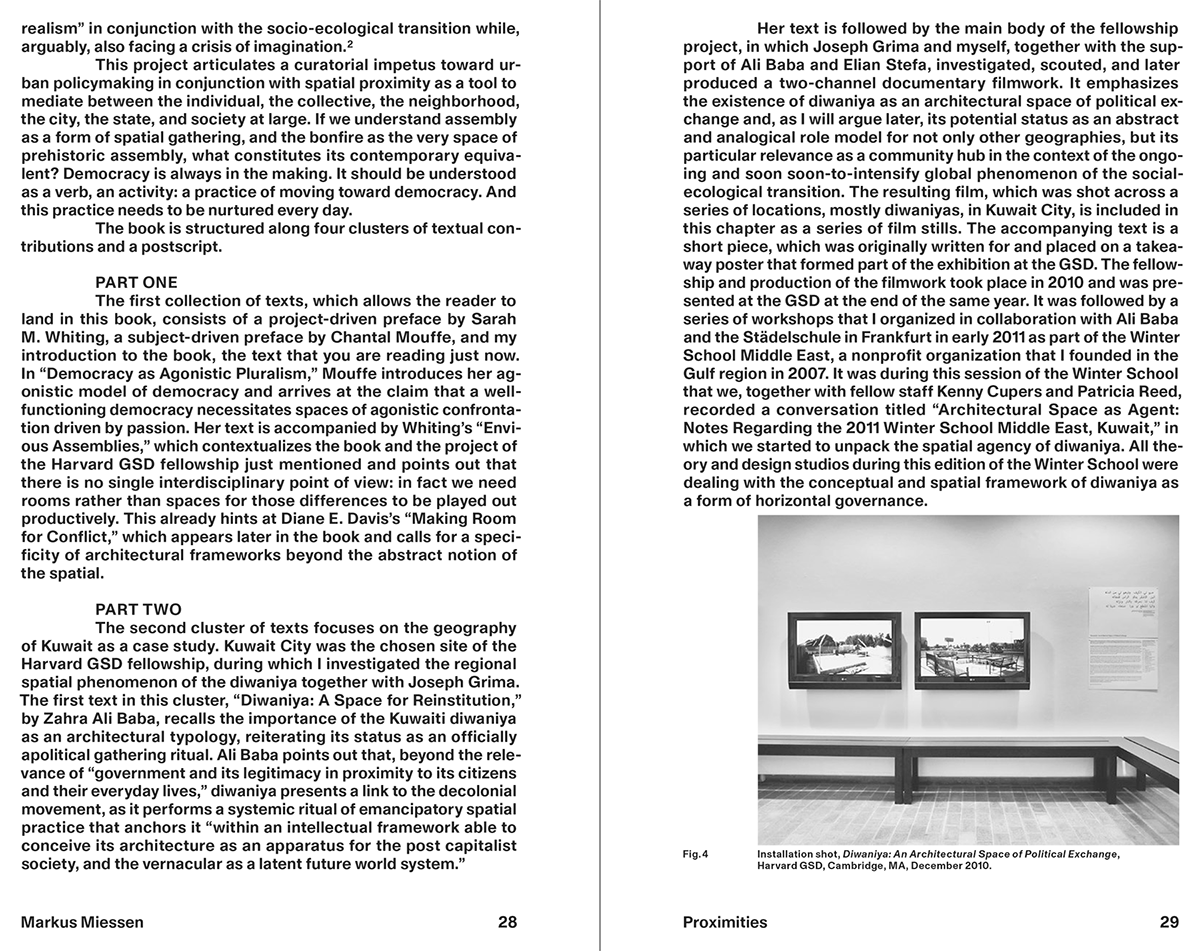Your cart is currently empty.
Cart

Agonistic Assemblies
On the Spatial Politics of Horizontality
Contributions by Zahra Ali Baba, Ole Bouman, Francelle Cane, Giancarlo De Carlo, Claudia Chwalisz, Kenny Cupers, Anne Davidian, Diane E. Davis, Erhard Eppler, Jesko Fezer, Joseph Grima, Amelie Klein, Charlotte Malterre-Barthes, Florian Malzacher, Markus Miessen, Chantal Mouffe, GUSTAV KJÆR VAD NIELSEN, César Reyes Nájera, Dennis Pohl, Patricia Reed, Vera Sacchetti, Nikolaj Schultz, Rahel Süß, Pelin Tan, Roemer van Toorn, David Mulder van der Vegt, Sarah M. Whiting, Mirjam Zadoff
This anthology presents work on cultures of assembly. It stresses the relevance of small-scale and decentralized spatial formats of local knowledge production to community building and embedded political decision-making in the context of the socio-ecological transition. It reinforces the role of both individual and collective action while proposing distributed assembly and proximity as core attributes in the production of the contemporary and future city. It calls for a revised form of spatial politics.
Miessen’s ongoing research trajectory Cultures of Assembly was initially kicked off during a Harvard GSD fellowship in collaboration with Joseph Grima, in which the two architects investigated the sociopolitical dimension of (urban) spatial design. Observing the Kuwaiti cultural and social landscape with a specific interest in the politico-spatial phenomenon of Diwaniya, this distributed urban form of para-institutional assembly established a starting point for a long-term body of research.
Diwaniya can be understood and interpreted in multiple ways. Beyond a techno-futuristic idea of progress, it presents a showcase of an alternative that attempts to imagine a model of a (more) solidary city. On the scale of a city, and in fact small country, it interrogates how we—as a society—can learn from and produce alternative formats of physical exchange, working towards realistic scenarios of decentralized decision-making and spatial justice.
Agonistic Assemblies asks: how can spaces—both physical and virtual—be envisaged to create publics? How is collectivity and society being generated spatially and in terms of policy? How do we “practice” society as a bodily, spatial form, and how does this practice contribute to spatial justice? Are there specific spatial settings that can intensify these practices? What kind of spatial design can we imagine as platforms for change?
Central to this project is the reflecting on and rendering of the underlying driving forces of informal institution building at the interface of agonistic (urban) spatial politics—in a global political climate facing what Mark Fisher famously framed as “capitalist realism” in conjunction with the social-ecological transition while, arguably, also facing a crisis of imagination.
This project articulates a curatorial impetus towards urban policy making in conjunction with spatial proximity as a tool to mediate between the individual, the collective, the neighborhood, the city, state politics, and society at large. If we understand assembly as a form of spatial gathering, and the bonfire as the prehistoric space of assembly, what constitutes its contemporary equivalent?








“Forums condition the speech acts delivered within them. This, as this book shows, is an architectural question: the arrangement of space bodies and media enable multiple potential speech acts; but each forum crucially also limits what can be said and done. Constraints, protocol, and process leave things unnoticed unheard, and thus left out of politics. This is perhaps the more crucial architectural question: this book calls for a set of spatial performances that can generate a rupture and with it expand our political imagination.”
— Eyal Weizman, founder and director of Forensic Architecture and professor of Spatial and Visual Cultures at Goldsmiths, University of London
“Given that today’s general context is one whereby we find ourselves all too often enveloped in self-similar thinking, fueled by social bubbles and social media, the lack of sameness in this volume leaves me envious, or at least hungry for more, which is, in the end, what feeds a future that promises to be better than the present, even if it might not be linear progress as such […] This book allows for conflict and in so doing makes room for productive and provocative thoughts and actions.”
— Sarah M. Whiting, Dean and Josep Lluís Sert Professor of Architecture, Harvard Graduate School of Design




